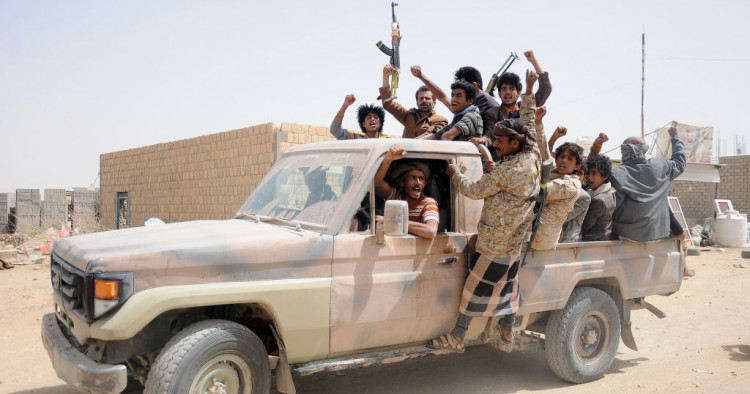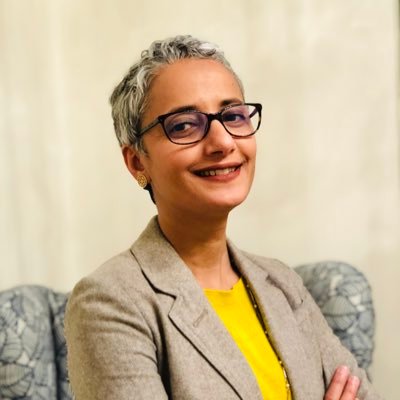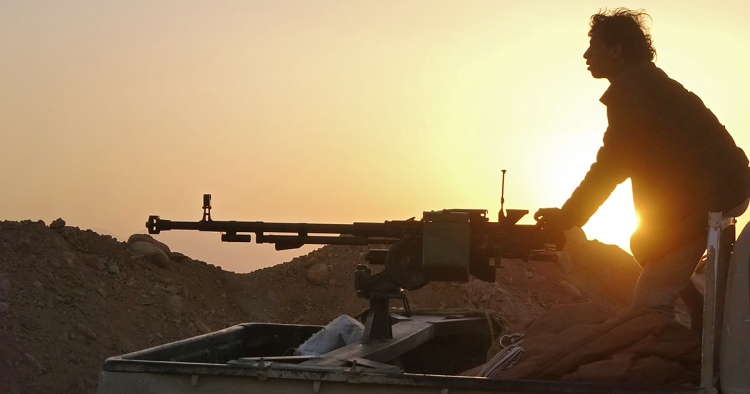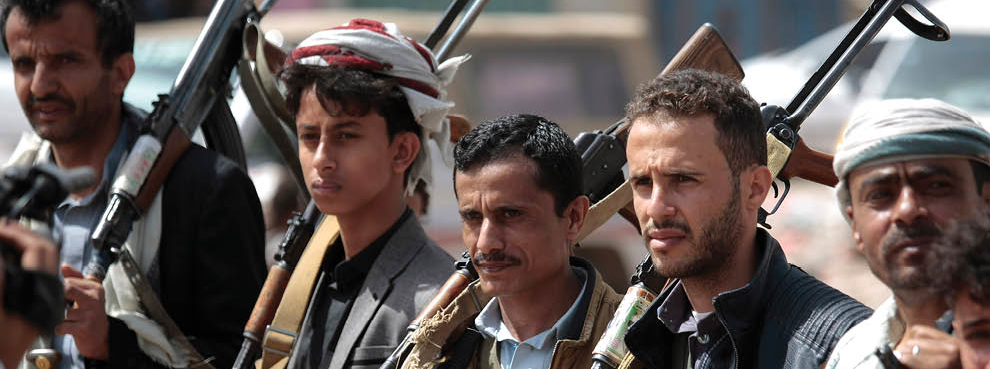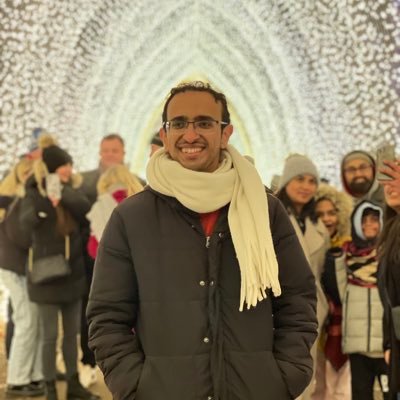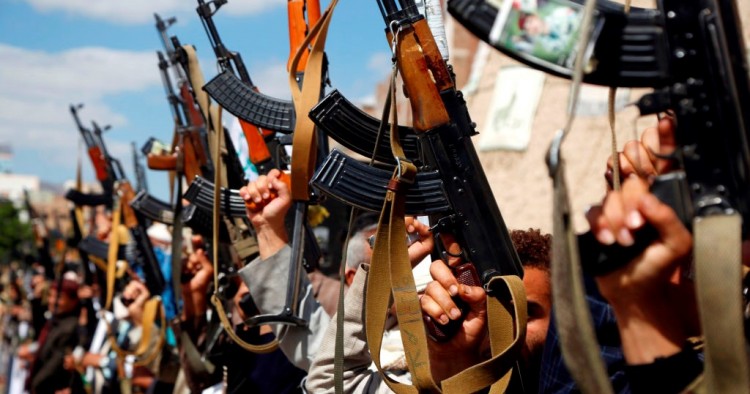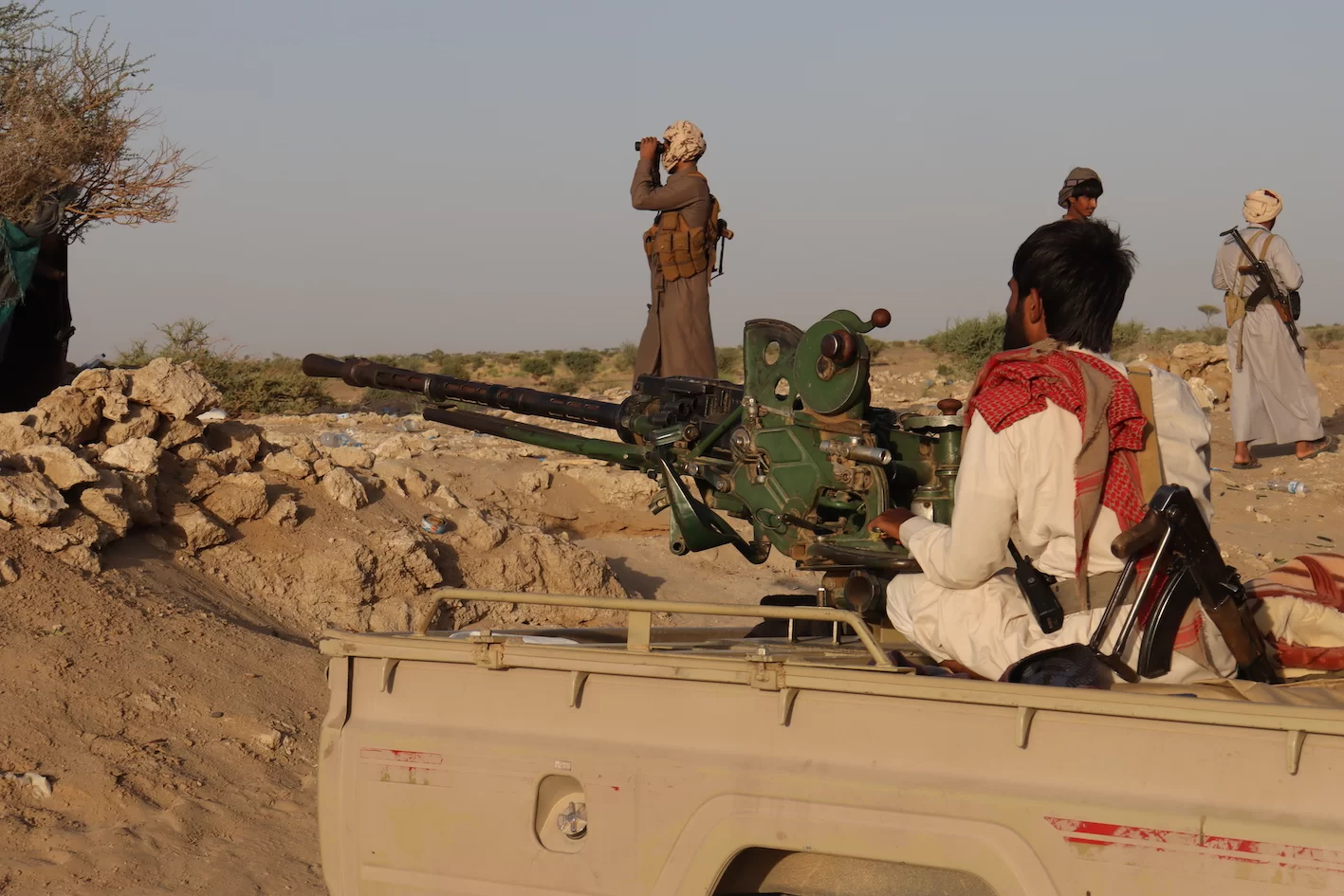President Joe Biden’s commitment to “stepping up” diplomacy to end the war in Yemen generated hope among peace practitioners and policy shapers. In February, the president appointed Tim Lenderking, a seasoned diplomat with solid experience in the region, as the U.S. special envoy to Yemen. To demonstrate his administration’s commitment, Biden stated he would end all American support for offensive operations in the war, including arms sales. He also rescinded the Houthis’ designation as a foreign terrorist organization.
Some observers celebrated Biden’s decisions as a “historic opportunity for peace,” encouraging the administration to double down on diplomacy by engaging Oman, Qatar, and Russia to build trust between the U.S. and the Houthis to generate momentum for a “political settlement.” Tapping into that momentum, the U.N. special envoy for Yemen, Martin Griffiths, visited Iran for the first time in early February, in a futile attempt to get the Islamic Republic to convince the Houthis to seize the opportunity. Most recently, Lenderking travelled to Oman and Riyadh, his fifth trip to the region since he was appointed in February, where he joined Griffiths and the P5 and held talks with key regional officials to push for a cease-fire. Much like Griffiths' attempts over the past three and a half years, this one also failed to gain traction. The Houthis have reportedly refused to meet the two envoys. “We are not where we would like to be in reaching a deal,” Griffiths said in a statement following the Oman tour.
Despite the unprecedented international commitment to bringing the war to an end, the situation continues to escalate. Following Biden’s decision, the Houthis stepped up their military offensive in a bid to capture the city of Marib, home to 3 million civilians and the last stronghold of the Yemeni government. They also dramatically increased their cross-border attacks, targeting Saudi cities and key infrastructure with dozens of drones and ballistic missiles. Some analysts argue that the Houthis’ escalation is an attempt to strengthen their negotiating position in anticipation of peace talks. Trying to interpret the Houthis through a pragmatic lens, however, might not be the best way to understand their intentions. A discussion of the political ideology of the rebel group is crucial to explain their actions and assess their appetite for diplomacy.
The Houthis’ ideology
The Houthis’ political ambitions are deeply rooted in a strong religious belief that only Ahl al-Bayt — a religious term that refers to the bloodline of the Prophet Muhammad — have a right to rule over Muslims. The Yemeni term for Ahl al-Bayt is Hashemites or Sadah (the plural of Sayyid), and Houthi leaders belong to that caste. In that sense, they are motivated by a desire to reinstate the Imamate, a theocracy in which Hashemites ruled parts of northern Yemen for hundreds of years until it was overthrown in 1962. They are also inspired by Wilayat al-Faqih (“the Guardianship of the Jurist”), a system of governance established by Ayatollah Ruhollah Khomeini following the Iranian Revolution of 1979 in which the ultimate political and religious authority lies in the hands of a supreme clerical leader.
According to Luca Nevola, the founder of the Houthi rebellion, Hussein al-Houthi, “developed an original politico-religious thought,” introducing ideas alien to Yemen’s Zaydi Shi’a tradition that led a number of Zaydi scholars to distance themselves from him.[1] The Houthis believe that both the founder of the movement and its current leader, Abdulmalik al-Houthi, are the guardians of the Quran, and that opposing them means going against the Quran. The “cultural and intellectual document” that serves as the Houthis’ manifesto states that God has chosen the Ahl al-Bayt to lead the Muslim ummah (community) and to guard the Quran until the day of judgment. The document was signed by key Houthi leaders, including Abdulmalik al-Houthi, in 2012. Abdulmalik al-Houthi now has the title of al-Alam or Alam al-Huda, which translates as “the icon of guidance,” symbolizing his sacred status as the supreme leader chosen by God and entitled to absolute and unconditional obedience by his people.[2]
Guided by this belief, the Houthis view themselves as the only legitimate authority to represent Yemenis and see the conflict as one between them and Saudi Arabia. In April 2020, the Houthis presented their “vision” to end the war “on Yemen.” The document had what Elana DeLozier described as a “wish list” of demands and gave no indication of a potential compromise. The eight-page document was written to be between two parties with room for two signatures, one for the “leadership of Republic of Yemen in Sanaa” and the other for the leadership of the Saudi-led coalition. The Houthis do not recognize Abed Rabbo Mansour Hadi’s government or any other actor that does not fall under their command, referring to them all as Saudi “mercenaries” and Dawaish, the Arabic term for ISIS. In March 2017, a Houthi-controlled court sentenced President Hadi and officials from his government to death for treason. Last December, the rebel group launched a missile attack that came close to killing the entire Yemeni government as they arrived at the airport in Aden.
Iran and the regional context
The Houthis’ military success in Yemen is also an important component of the rise of Iran in the region. The link between the Houthis and Iran is an aspect that mainstream analysts often downplay and sometimes even dismiss altogether. The Houthis’ actions are largely inspired by the Iranian Revolution and they seek to replicate it in Yemen with Iran’s help. Indeed, the Islamic Republic has seen the gains from its decades of slow, yet consistent, investment in the Houthis realized in the past six years.
Iran’s support for the Houthis goes back to the early 1980s, involving training, indoctrination, asset recruitment, and the gathering of intelligence.[3] Hussein al-Houthi was strongly inspired by the Iranian Revolution and was devoted to importing it to Yemen. He and his father studied in Qom in Iran in the mid-1980s, while he and his brother, Abdulmalik al-Houthi, the movement’s current leader, spent time in Iran and southern Lebanon during the late 1980s and the 1990s.[4] In one of his recorded lectures, Hussein al-Houthi described the Iranian Revolution as the best example to follow to confront America and Israel. He believed that Iran with its anti-imperialistic agenda could lead the Arabs toward glory.[5] Even today, Hussein’s lectures form the bulk of the curriculum that the Houthis use to indoctrinate their followers. They are centered around the importance of jihad against America and Israel, the rejection of reforming religion, and the need to preserve the unity of Muslims by avoiding democracy, which he deemed “an alien concept” whose “end goal is to allow Jews to rule over Muslims.”[6]
By the late 1990s, Hussein al-Houthi had hijacked, militarized, and radicalized the Zaydi revivalist movement, transforming the Believing Youth Forum into the Believing Youth Organization (BYO) and establishing a tight grip over it. Between 1999 and 2004, the BYO conducted activities under the stewardship of Hussein, including screening films from the Iranian Revolution and Hezbollah for tens of thousands of youth across the north.[7] In 2002, following the terrorist attacks of Sept. 11, the BYO led by Hussein al-Houthi adopted a modified version of the Iranian Revolution slogan, “Death to America, Death to Israel, Curse the Jews, Glory to Islam.” In the following years, the Houthis started digging trenches and defensive positions in the areas of Marran and Dahyan in Saada. In 2004, they picked up arms and fought the Yemeni government, a conflict that lasted until 2010 and became known as the Six Wars or Saada Wars.[8]
Almasdaronline news website published a secret document that reveals training material dating back to 2005 that was used to train the Houthis on how to fight urban warfare and capture cities. The cover page has pictures of Iranian Supreme Leader Ayatollah Ali Khamenei and Hezbollah leader Hassan Nasrallah[9] and the material was authored by Abu Hadi, an Arabic-speaking commander with Iran’s Islamic Revolutionary Guard Corps (IRGC) who in later years vetted Houthis in Beirut before sending them to Iran.[10]
The political turmoil that followed the Arab Spring in 2011 created an opportunity for Iran to increase its investment in the Houthis. At the beginning, the Islamic Republic delegated that mission to Hezbollah, which started training and helping the Houthis organize, but over time Iran increased its direct engagement with them.[11] Iran and Hezbollah’s support for the Houthis — in the form of financing, training, military expertise, political and media organizing, and weapons — increased dramatically during the current war and it has been instrumental in the group’s rise. The Islamic Republic admitted in 2014 that it had a few hundred military personnel from the Quds Force, a branch of Iran’s IRGC, in Yemen aiding the Houthis.
Most prominently, two senior Quds Force commanders are currently in Yemen, Hasan Irlu and Abdul Reza Shahlai; the latter was sanctioned in 2008 for his role in establishing Iranian proxies in Iraq. In January 2014, a prominent sheikh from Saada mentioned at a public event that Shahlai, along with other Iranian experts, had been in Saada supervising Houthi military operations, which suggests that Iran’s military support for the Houthis dates back to well before the war started in September 2014. In a televised speech in 2019, Hezbollah leader Hassan Nasrallah spoke with pride about Hezbollah “martyrs” who had died fighting with the Houthis in Yemen. In April 2021, the assistant commander of the IRGC Quds Force, Rustam Qasimi, admitted that Iran has military advisors in Yemen and that the Islamic Republic aided the rebel group in manufacturing missiles and drones. With the help of Iran and Hezbollah, the Houthis transformed from a militia relying mainly on small-arms ambushes to a military power to be reckoned with — and one that poses a significant challenge to security in the region.
As a political Islamist group and a member of Iran’s Axis of Resistance, the Houthis are transitional by nature; they are part of a global jihadi effort to unite the Muslim world. Maysaa Shujaa al-Deen points out that the Houthis describe their expansion as being on “the Quranic path,” indicating an ongoing journey that starts with Yemen and aims at the “liberation” of Jerusalem. Indeed, the Houthis often characterize their fight in Yemen as part of a larger Islamic agenda. Houthi leader Mohammed al-Bukhaiti said that the rebels’ recent push into Marib was “implementing the will and orders of God,” adding that Marib is the “gate to Jerusalem.” Iranian and Hezbollah media have lent moral support to the Houthis’ military campaign throughout the war. Commenting on the battle of Marib, the Iranian Mehr News Agency published an article days before Ramadan with the title, “tomorrow we will fast in Marib and break our fast with its dates,” signaling the strategic importance of the Houthi takeover of Marib for Iran.
Building the Houthis’ police state
Over the past six years, the Houthis have “constructed a regime that corresponds to their aspiration to emulate the Iranian revolutionary system,” according to Mohammed Almahfali and James Root. The Houthis developed a highly repressive security system akin to Iran’s IRGC, known as preventive security, which a U.N. panel of experts in Yemen describe as the most influential intelligence apparatus in Houthi-controlled areas. It operates outside state structures and reports directly to Abdulmalik al-Houthi. Sources indicate that Iranian and Hezbollah trainers helped set it up in Saada first before expanding it to Sanaa. The apparatus played a critical role in eliminating Ali Abdullah Saleh in 2017, their former ally and Yemen’s former president, as well as his loyalists.[12]
While they continue to expand militarily, the Houthis have also embarked on a mass indoctrination of Yemenis, particularly children, in anticipation of a long war. They have replaced the educational curriculum with new materials that reinforce the concept of the Iranian Revolution, glorifying jihad and encouraging children to fight against “Zionist-American hegemony.”
The end game
Since 2015, it’s become evident that the Houthis not only refuse to deescalate, but also use cease-fire opportunities to reposition their forces and expand militarily. They exploited the cease-fire that was agreed to under the Stockholm Agreement in December 2018 and escalated their military offensive, making significant military gains in Bayda, al-Jawf, and Marib. Most recently, they have rejected proposals by the U.S. envoy and Saudi Arabia to establish a nationwide cease-fire while they continue their relentless military push toward Marib, disregarding calls by the U.N. and other international actors.
The current diplomatic efforts to end the war in Yemen are hanging on by a thread, as they are entirely based on the delusion that the Houthis are open to a political solution with other Yemeni forces, even when the rebel group continues to thwart these efforts time and again. The Houthis have stated publicly and repeatedly that they want an unconditional end to the Saudi-led coalition’s military intervention and the withdrawal of its forces from Yemen. That is their definition of “ending the war in Yemen.” They are determined to take Marib and the rest of Yemen. The Russians, Omanis, Qataris, Europeans, and the U.N. combined do not have the influence to convince them to change course. Over the past six years, Saudi military intervention has also failed to weaken the Houthis militarily and to compel the rebel group to come to the negotiation table in good faith. While Iran does not have a command-and-control relationship with the Houthis, the rebel group is part and parcel of Iran’s expansionist agenda. The two have their eyes on the prize, which is bringing the region under the control of Iran and its proxies, and they are in it for the long haul. Failing to recognize that will only lead to misguided policies that will likely contribute to prolonging the conflict in Yemen and fail to address the broader security threat posed by Iran in the region.
Nadwa Al-Dawsari is a non-resident scholar at the Middle East Institute. Before joining MEI, she was the Yemen country director for Center for Civilians in Conflict, a senior non-resident fellow at the Project on Middle East Democracy, and a founding director of Partners Yemen, a local affiliate center of Partners Global. The opinions expressed in this piece are her own.
Photo by Stringer/Getty Images
Endnotes
[1] Nevola, L., From Periphery to the Core: A Social Network Analysis of the Ḥūthī Local Governance System, VERSUS Working Paper, July 2019, University of Sussex.
[2] Interview with a scholar specialized in Zaydism, September 22, 2020. See also Hussein al-Houthi’s lecture on Al-Welayah (Guardianship or Mastership), December 21, 2002, http://www.d-althagafhalqurania.com/index
[3] Almasdaronline (Arabic), “Houthis in secret document (2) … intelligence report about Iran’s efforts to set foot in Yemen since the 1980s,” April 16, 2020, https://almasdaronline.com/articles/180629
[4] Mohammed Khairi, “Dawafa’a mosanadat Iran lel Hotheieen fi Alyaman” [The motives behind Iran’s support for Houthis in Yemen], October 23, 2019, https://afaip.com/دوافع-مساندة-إيران-للحوثيين-في-اليمن/ ; Dr. Saud Al-Mawla (2015), Houthis and the New Yemen: The Conflict of Religion, Tribe, and Neighbor, Sa’aer Almashriq (Entire East).
[5] Mohammed Al-Maflahi and James Root, “Althawra Al-Islamiyah Al-Iraniyah: Kaif tolhim aw la tolhim hokm alhotheieen fir shamal Alyaman” [The Iranian Islamic revolution: How it inspire or not inspire the Houthis in north Yemen], Sana’a Center for Strategic Studies, March 5, 2020, https://sanaacenter.org/ar/publications-all/analysis-ar/9182
[6] Maysaa Shuja al Deen (Arabic), “Alhouthi wa mohimat ihtikar al-Ta’ifah,” [Houthis and the mission of monopoly of the sect], March 21, 2015, https://www.alaraby.co.uk/الحوثي-ومهمة-احتكار-الطائفة
[7] Barak A.Salmoni, Bryce Loidolt, Madeleine Wells (2010), Regime and Periphery in North Yemen: The Huthi Phenomenon, The RAND Corporation, https://www.rand.org/content/dam/rand/pubs/monographs/2010/RAND_MG962.pdf
[8] Oved Lobel, “Becoming Ansar Allah: How the Islamic Revolution Conquered Yemen,” European Eye on Radicalization,” March 20, 2021, https://eeradicalization.com/becoming-ansar-allah-islamic-revolution-yemen-oved-lobel/
[9] Almasdaronline, “Houthis in special document (11) urban warfare..training plan dates back to 2005 to train Houthis on occupying Yemeni cities,” April 18, 2021, https://almasdaronline.com/articles/222105
[10] Baraa Shaiban, “Yemen’s Clash of Two Revolutions,” Hudson Institute, April 21, 2021, https://www.hudson.org/research/16848-yemen-s-clash-of-two-revolutions
[11] Baraa Shaiban, “Yemen’s Clash of Two Revolutions,” Hudson Institute, April 21, 2021, https://www.hudson.org/research/16848-yemen-s-clash-of-two-revolutions
[12] Republican Yemen, “Al-Amn Alwoq’ai Alhouthi… Sejel min Aljara’im wa alintihakat behaq alyamaniyeen,” [Houthi preventative security… a record of crimes and violations against Yemenis,” February 16, 2019. https://republicanyemen.net/archives/14492?fbclid=IwAR1By1GsyqvX4jhdDEFVlglSCvMYHVKIAC2sDZvoOOqYxTLSnBpnbcRR
